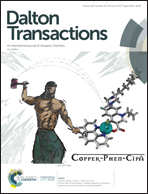Charge, adsorption, water stability and bandgap tuning of an anionic Cd(ii) porphyrinic metal–organic framework†
Abstract
Due to the designability of metal–organic frameworks (MOFs), semiconductor MOFs have become the focus of research as photocatalysts of useful chemical processes utilizing clean solar energy. In this work, we developed a method of tuning the framework charge of MOF materials and determined how the framework charge can affect the band edge positions and bandgaps of the novel anionic Cd(II) porphyrinic metal–organic framework (PMOF) 1 ([Cd3.2(H2TCPP)2][(CH3)2NH2]1.6). It was constructed from H2TCPP4− (H6TCPP = tetrakis(4-carboxyphenyl)-porphyrin) and Cd(II), forming a tube-like structure, and shown to have a negatively charged framework with a 60% occupancy of one type of Cd(II) ion. By increasing the reaction time and the amount of Cd(II) ions in the reactants, the nearly neutral counterpart of PMOF 1 was also obtained. The [(CH3)2NH2]+ counterions of PMOF 1 were also exchanged with Li+. Although the surface area of PMOF 1 and its derived PMOFs were only 407–672 m2 g−1, the CO2 and CH4 uptakes reached, respectively, 44–65 ml g−1 (8.7–12.7%) and 22–26 ml g−1 (1.6–1.8%) each at 1.0 atom and 273 K; at 9.0 atm these values nearly tripled. Li+-exchanged 1 favoured N2, CO2 and CH4 adsorption, especially at 9 atm and a relatively low temperature (273 K). PMOF 1 subjected to a solvent exchange process showed an unstable structure in water, while PMOF 1 not subjected to this process was found to be stable in water. Thus, a method for making water-stable divalent-metal carboxylate MOFs was proposed. The counter ion type showed little effect on the band-edge positions and bandgaps, but the framework charge did show effects. Under visible light and with tris(2,2′-bipyridine)dichlororuthenium(II) (Ru(bpy)3Cl2) as the co-catalyst and triethylamine (TEA) as the sacrificial agent, the efficiency of CO production resulting from CO2 reduction using 1-DMF reached 56 μmol g−1 h−1, about 5 times greater than that for the system without using Ru(bpy)3Cl2.



 Please wait while we load your content...
Please wait while we load your content...